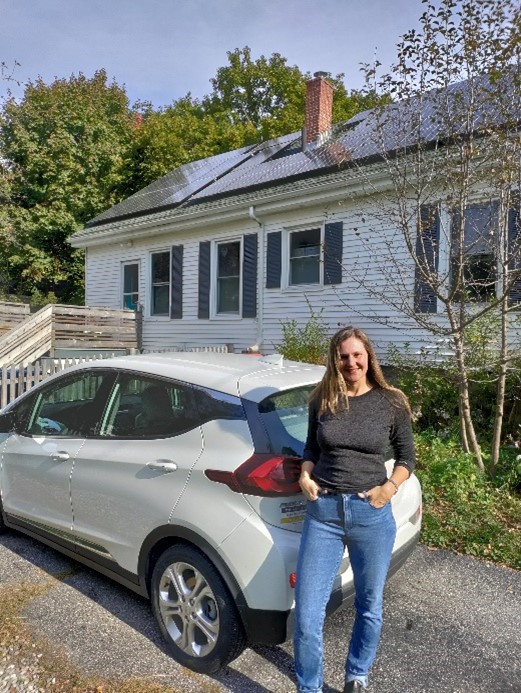Zondits Clean Energy Journal.
This is the first entry in a new Zondits feature that invites our readers to contribute personal experiences in their clean energy journey. Zondits wants to know: What clean energy technology have you personally experienced in your life and what’s your take on it? Send your submissions to info@zondits.com.
The following article is an account of writer Camryn Hansen’s family trip in their EV. It chronicles their experiences including route planning, charging stops, and a concert in an apple orchard.
People want to drive EVs, for all the reasons you already know. But people are also apprehensive about driving them, especially long distances where they’ll have to worry about how and where to charge. I drove an EV for five years before I took a really long trip in one. This was partly due to COVID, but partly because the logistics of DC fast charging seemed too daunting to navigate.
Over the summer I took my family (my partner and our three boys ages 3, 8, and 11) on our first long-distance trip in our EV—from Southern Maine to Central New York. I want to share how we did it so that I can spare you the anxiety I had in the weeks leading up to it, and maybe even get you excited about the incredibly cool and genuinely helpful technology that is growing up around EVs.
If you drive a gas car, you already know that there’s no material difference between driving around town and driving long distances. Gas is gas, and when you’re running out, you go to one of the gazillion gas stations that surround you as reliably as death and taxes, and you refill your tank. If you’re near home, you go to your neighborhood gas station. If you’re far from home, you go to some other gas station where the procedures are the same.
Switching to an EV requires something of a paradigm shift. How you charge your car for your everyday driving needs might be completely different from how you charge your car on a long trip. For me, routine charging for everyday driving involves nothing more than parking in my driveway and plugging into a 240 V dryer outlet I had installed on the outside of my house. Once I set this up, I stopped having to think about it. This is my EV comfort zone.
My trip from Maine to New York sent me way out of my EV comfort zone and into the exotic world of DC fast charging.
My EV: A 2020 Chevrolet Bolt. EPA-estimated range: 259 miles. That number means that when your car is fully charged, you can generally drive 259 miles before it’s completely out of energy and needs to be charged again. In reality, I’ve found that the mileage I get depends heavily on what I’m doing with the car: whether I’m using the air conditioning or heat (heat uses the most energy), whether I’m driving on the highway or back roads (the highway uses the most energy), and whether the weather is extremely hot or cold (temperate weather gets the best mileage). In summers in Maine, when I’m fully charged my range will sometimes show up to 425 miles.
My itinerary: Driving from Portland, Maine to Utica, New York to visit my in-laws (360 miles one way). While we were there, we also had tickets to see a band (The War on Drugs) play on an apple orchard in rural LaFayette, New York (77 miles one way from Utica).

How I prepared: My first stop for information-gathering was my Chevrolet Bolt owners group on Facebook. This group includes people from all over the country and the world who drive Bolts around all day and know what they’re talking about. Ask any question and you’ll get at least a couple dozen helpful responses. If you have a very technical question or problem, “your friendly neighborhood GM tech” will generally pop in with a rigorous answer. So I posted in the Bolt owners group telling them about my trip and asking how I can figure out where to charge along my route.
Responses quickly materialized from the ether: Download an app called A Better Route Planner; download the Plug Share app. Use the Route Planner to plot out where to charge along your route and for how long. Then use Plug Share to check that the charging stations A Better Route Planner gave you are actually reliable. As you will see, these two apps lived up to the hype and worked as promised.
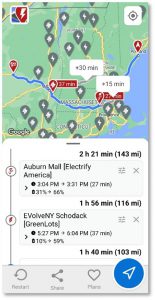
How these EV charging apps work: A Better Route Planner (ABRP) works a little like Google Maps but customized to your particular EV. You enter your EV model information and how full your battery will be when you leave (charged to 100%, to 80%, etc.). Then you put in your start and end points. ABRP then does a little calculating and tells you exactly where to stop to charge, what percentage your battery will be at when you arrive, what percentage you’ll need to charge to before leaving (you don’t “fill up,” you only charge enough to make it comfortably to the next stop), and how long it will take to charge that much. For some stations, this app also shows how much it will cost to charge.
Because ABRP is customized to your EV, it will only show you chargers that are compatible with your car. In 2022, we are still in the Wild West of EV chargers, because different car companies developed different charging technologies and we’re still using several of them. It’s like back in the 80s and 90s when we had VHS and Beta VCR tapes until VHS finally won out and became the only technology available at places like Blockbuster Video, so the Beta people had to cave. Or like iPhones and Android phones today.
For the fastest level of charging, called DC fast charging, there are three types of chargers: CCS, CHAdeMO, and Tesla Superchargers. If you have a car with a CCS charging port, you can’t plug in at a Tesla charging station and vice versa (unless you have an adapter, but let’s not get into the weeds). The Bolt, like most of the non-Tesla EVs coming out today, uses CCS charging. This means that although my mother-in-law assured me there was a whole line of EV chargers in the Price Chopper parking lot right near her house in Utica that I could use, it turned out that I couldn’t because they were all Tesla chargers. Knowing this, my ABRP app acted as though the chargers at the Utica Price Chopper didn’t even exist.
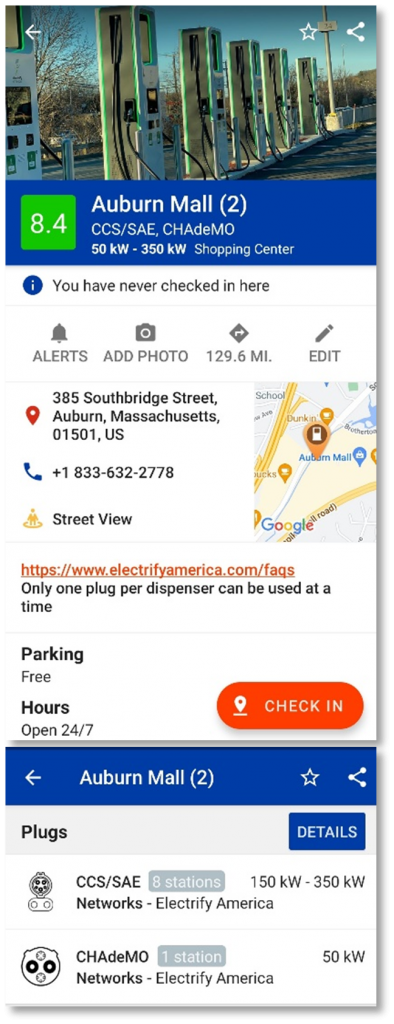
This brings up a good point. What if the chargers ABRP tells you to stop at aren’t working, or are in use when you get there? This is where the app Plug Share becomes spectacularly helpful. You can type in the location of any charger and find out a whole bunch of information: the exact street address, what types of plugs it has, how many of each type of plug and how much electricity they deliver, any parking fees, hours of operation, and how reliable the chargers have been for real-time users on a scale of 1 to 10. It shows real pictures of the chargers and you can click into a Google street view of the charging stations and their surroundings so you’ll know what to look for when you get there. It also tells you whether any of the chargers are in use at the present moment. For example, it might tell you that a Hyundai Ioniq 5 is currently charging and should be gone in 24 minutes.
Double checking my charging stops: For my trip to Utica, ABRP told me my first charging stop should be at the Auburn Mall in Massachusetts, where the chargers are from Electrify America. So I opened the PlugShare app to check out the Auburn Mall charging stations (to the left are screenshots from the app). They were listed as 8.4 reliable on a scale of 1 to 10, and I could read positive comments from users who had recently charged there.
But I was traveling with three kids. Was this charger ok for when you’re traveling with three kids? It’s outside of a mall! With a food court! So yes. We decided we would stop at the Auburn chargers, plug in, go into the mall, and have lunch while we waited. This charging stop was a good choice.
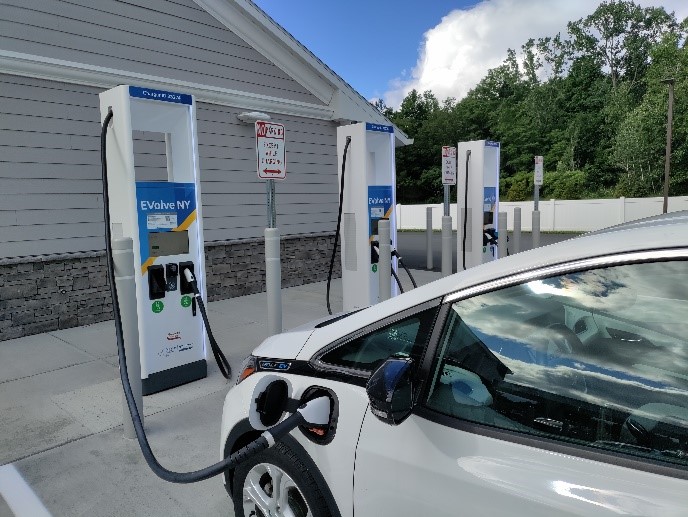
After that I checked out the second stop from ABRP (DC fast chargers from Evolve NY at Stewart’s Shops in Schodack, NY) on PlugShare. These too had a high rating of 8.0 and were at a gas station with a convenience store. This seemed like a good choice for stopping too.
Satisfied, I went back to ABRP and sent the whole trip to Google Maps. When you do this, Google Maps treats the charging stations as waypoints and takes you from waypoint to waypoint.
The trip went like clockwork after that. We found every charging station on our route where it was supposed to be and in good working order. When we stopped to charge, we used the waiting time for meals and bathroom trips so that we were never really “waiting.” To my delight, I never paid more than $10 for any charging session, and the whole trip from Portland to Utica and back, including our side-trip to LaFayette (almost 900 miles total), cost about $30 total in charging fees. The price of gas at the time was more than $5 a gallon.
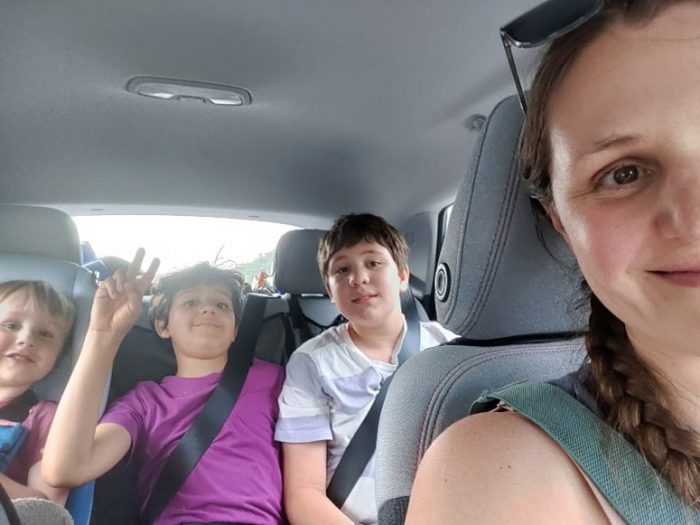
This adventure emboldened me with my EV. A week after I got home, I drove from Portland to Bangor and back for an event (215 miles round trip) and used PlugShare to find a level 2 charger in Bangor where I parked during the event and charged to 100% for free. From here on out, it’s only going to get easier to plug in.

